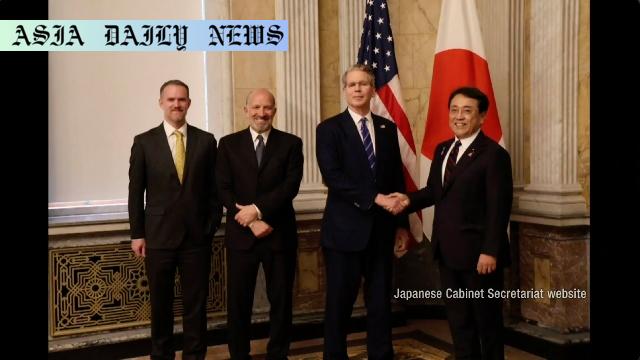Tariffs: Japanese negotiators seek to expedite trade negotiations with the US to address sweeping tariff challenges.
Tariffs and trade remain key focus of Japan-US negotiations.
Akazawa pushes for revised tariffs and expedited resolution.
Prime Minister Ishiba considers talks forward-looking.

Introduction: Japan’s Push for Tariff Adjustments
The recent trade negotiations between Japan and the United States have placed tremendous focus on tariffs. Japan’s economic revitalization minister, Akazawa Ryosei, has taken the lead in initiating dialogue with US officials to address the sweeping tariff measures introduced under President Donald Trump’s administration. The goal is to create a mutually beneficial agreement that supports economic growth for both nations while easing trade tensions.
As of now, Japan’s government officials are working diligently to find common ground with the US. Akazawa has expressed optimism about the ability to reach agreements soon amidst ongoing discussions, making this a pivotal moment in Japan’s trade diplomacy.
Role of Akazawa Ryosei in Negotiations
Akazawa Ryosei, serving as the chief tariffs negotiator and economic revitalization minister, has been a key figure in these talks. His recent trip to Washington included meetings with US Treasury Secretary Scott Bessent as well as other high-ranking officials. Akazawa arrived back in Japan after the second round of discussions, bearing detailed insights and strategies to brief Prime Minister Ishiba Shigeru.
Akazawa’s mission is not easy. With steep tariffs impacting trade dynamics, convincing the US side to reconsider their positions requires both diplomatic finesse and compelling economic arguments. Furthermore, the urgency in resolving this issue before the next round of ministerial talks in May reflects how the two nations aim to avoid prolonged economic tensions.
Prime Minister Ishiba’s Perspective
Prime Minister Ishiba Shigeru has placed significant trust in these discussions. While acknowledging that no concrete agreement has yet been reached, Ishiba described the recent round of talks as “forward-looking” and “constructive.” This statement reflects cautious optimism tempered by the acknowledgment of critical challenges that remain unresolved.
Under Ishiba’s leadership, Japan aims to explore avenues for compromise where both countries can make meaningful concessions. In a world increasingly impacted by protectionist policies, securing a balanced trade agreement with the United States remains a priority that could set the course for Japan’s economic trajectory.
Challenges Ahead for Japan and the US
Despite these constructive talks, significant challenges lie ahead. The tariff structure introduced by the US under Trump’s policies has deeply affected key industries in Japan. Sectors such as automotive and technology innovation have faced undue pressure, forcing Japan to advocate strongly for exceptions or revisions to these measures.
However, the US stance is not without merit. Their concerns over competitiveness, domestic industry protection, and trade imbalances require careful consideration. This makes crafting a solution that suits both sides a complicated balancing act. Akazawa and Ishiba must also assess Japan’s willingness to offer concessions while safeguarding their national interests.
The Road to a Final Agreement
The timeline for the next round of ministerial discussions in mid-May introduces a sense of urgency into the process. According to Akazawa, speeding up negotiations will be pivotal to reaching an agreement in the near term. Both governments seem open to compromise; identifying specific areas of mutual accommodation is essential to achieving tangible outcomes.
Japan has historically demonstrated a commitment to free and fair trade, viewing robust partnerships as central to its economic policy. The current focus is now on accelerating these efforts, leveraging diplomatic relationships, and ensuring clarity in communication at each stage of the negotiations. Ultimately, a successful resolution would symbolize cooperation between the US and Japan during challenging geopolitical and economic times.



Commentary
The High Stakes of Japan-US Trade Relations
The ongoing trade negotiations between Japan and the United States spotlight the intricate balance nations must strike in navigating global economic partnerships. For Japan, these talks are not just about revising tariffs but redefining its trade relationship with a key ally.
The leadership of Akazawa Ryosei embodies Japan’s strategic approach to diplomacy. By prioritizing dialogue and pushing for expedited solutions, Akazawa reflects Japan’s deep understanding of how modern economic challenges demand prompt yet thoughtful responses. His frankness in addressing the urgency to finalize an agreement is commendable.
The Need for Collaboration
Prime Minister Ishiba has rightly emphasized the “forward-looking” nature of the talks. Forward momentum in diplomacy is crucial, particularly when protecting national industries and advancing economic growth. Japan’s willingness to explore areas of mutual concession without compromising its fundamental interests has made this negotiation period a testament to strategic adaptability.
At the same time, it is essential to recognize the complexities stemming from US objectives. Engaging with an administration that prioritizes protectionist policies calls for precision in crafting arguments that address mutual concerns. A collaborative approach ensures that both parties emerge stronger, paving the way for enhanced bilateral relations.
Looking Toward the Future
What lies ahead could serve as a blueprint for global trade practices. If Japan and the US can successfully navigate this challenge, the outcome could inspire other nations embroiled in tariff disputes. For Japan, this is an opportunity to showcase its resilience and determination in an ever-changing global landscape.
What remains clear is that both sides must demonstrate patience, vision, and creativity. Failure to do so could hinder economic opportunities and strain diplomatic relations. As the narrative unfolds, the world will watch to see if Japan and the US can rise to the occasion.